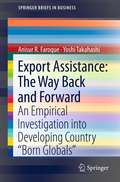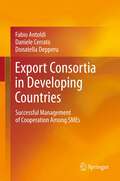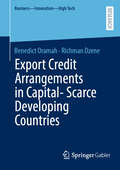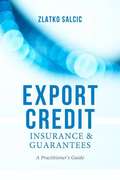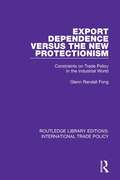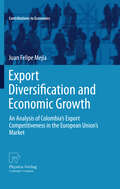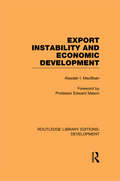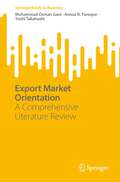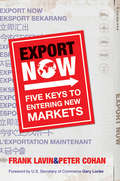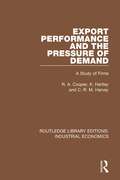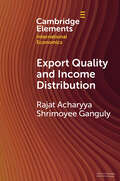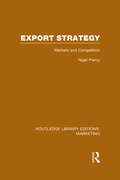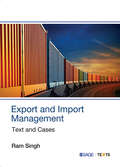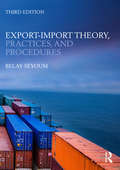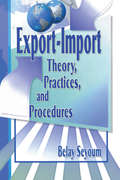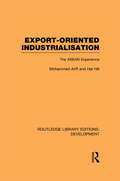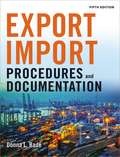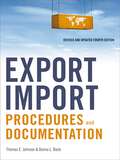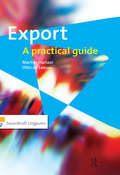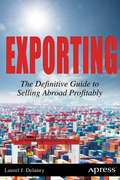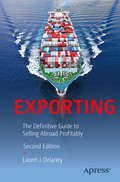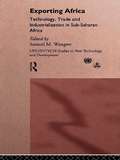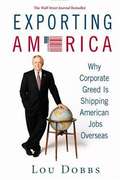- Table View
- List View
Export Assistance: The Way Back and Forward
by Yoshi Takahashi Anisur R. Faroque"Born global" (BG) firms have attracted many researchers throughout the last decade. The emergence of this phenomenon initially posed a serious challenge to the validity and applicability of the traditional "stage" theory of internationalization; however, scholars have more recently been able to reconcile traditional and new theories into a single framework for studying the process of internationalization. This volume applies both network theory and knowledge-based theory to analyze export assistance in the context of internationalization of low-tech BG firms in developing countries (with an in-depth study of the apparel industry in Bangladesh). The findings that non-governmental network partners provide more useful advice than government agencies is one that may resonate through other countries, including developed economies. Government's more useful role is confined to the financial support and incentives that are provided to such firms. It is, however, the commitment to exporting that emerges as critical for performance, more so than export strategy, suggesting that enhanced export performance is to attract, reassure and motivate entrepreneurs in ways that strengthen their commitment to international expansion.
Export Consortia in Developing Countries
by Donatella Depperu Fabio Antoldi Daniele CerratoThe book analyzes export consortia from the strategic management perspective. It builds on an empirical analysis of nine export consortia promoted by UNIDO in developing countries between 2004 and 2007. The book is based heavily on actual export consortium experiences, in order to combine a rigorous research approach with a more pragmatic view of the phenomenon. The material will be of interest to a variety of readers. Scholars in the field of management represent the authors' primary target. The book includes a literature review which combines the topics of SME internationalization, strategic networks, and the issues which relate specifically to SME alliances in the form of export consortia. Entrepreneurs and executives will find useful business models and management tools for the successful design and implementation of export consortia. Insights into the functioning of export consortia may also be of interest to policy-makers and institutions that develop support programs for the growth of SMEs in developing countries.
Export Credit Arrangements in Capital-Scarce Developing Countries (Business - Innovation - High Tech)
by Benedict Oramah Richman DzeneSince the emergence of Export Credit Agencies (ECAs) in and around the 1900s, they have underpinned the trade, industrial and economic expansion of many economies of the world. These institutions were at the heart of the industrial revolutions of advanced economies of the early 1900s and the emergence of many Asian economies, such as China and India. In this book, we highlight the evolution of ECAs globally and in developing countries, outlining the significant changes that have occurred, and present case studies of selected ECAs to elicit differential experiences and lessons, which will constitute the guiding principles for the revival or creation of ECAs in developing countries. These principles are particularly imperative as governments in Africa and elsewhere have either most recently established or are contemplating the establishment of ECAs.
Export Credit Cover Policies and Payments Difficulties
by Chanpen Puckahtikom Eduard H. BrauA report from the International Monetary Fund.
Export Credit Insurance and Guarantees
by Zlatko SalcicThe first practitioner handbook on export credit insurance and guarantees, providing manufacturers, exporters, bankers, and lawyers with a much needed resource. The book contains descriptions and analyses of almost every type of export credit insurance and guarantee used in international trade with explanations about the risks inherent in each.
Export Dependence versus the New Protectionism: Constraints on Trade Policy in the Industrial World (Routledge Library Editions: International Trade Policy #11)
by Glenn Randall FongIn an international political economy characterised both by constancy and change, this study, first published in 1996, links together one seemingly incongruous continuity in international trade relations with an increasingly dramatic development in the economies of industrial countries. On the one hand, industrialised countries have become progressively dependent upon one another. On the other hand, the liberal international trade regime has yet to falter. These two points are tied together by seeking to explain the maintenance of liberal trade relations in terms of the mutual economic dependence of industrial countries. In particular, the study examines what may be a fundamental constraint on trade protectionism today: the reliance of industrialised countries on external trade relations, and especially on markets within the industrial world.
Export Diversification and Economic Growth
by Juan Felipe MejíaThe main research problem addressed in the book is the one regarding the role that export diversification could play for enhancing economic growth in Colombia, both in terms of new products and new geographic markets. The underlying motivation for centering the analysis on the European Union's market are manifold, reaching from the evident concentration of exports - both in terms of composition and markets- that Colombia still shows, to the small amount of empirical studies analyzing the current status and potentialities of the commercial relations between Colombia and the European Union.
Export Instability and Economic Development (Routledge Library Editions: Development)
by Alasdair I. MacbeanWhen this work was first published in 1966, there was much interest in various types of commodity agreements and compensatory financing as methods of reducing the effects of export fluctuations on the economies of developing countries. The book concluded that short term fluctuations in export earnings, though perhaps important for some countries, did not appear to be the general problem that had been assumed. If correct, it would suggest that any measures should be carefully designed to fit the situations of countries that were affected and be subjected to cost-benefit analysis. This led to many published and unpublished studies on the issues: some supported, others contradicted the book’s conclusions. The data available now are vastly greater and probably more accurate than pre-1966. However, the work and the issues it raised remain important because most schemes proposed to reduce export instability would be costly and likely to divert resources from uses more obviously aimed at raising economic development in most developing countries.
Export Market Orientation: A Comprehensive Literature Review (SpringerBriefs in Business)
by Yoshi Takahashi Anisur R. Faroque Mohammad Osman GaniThis book integrates the fundamental concept of international business theory, internationalization theory, and market orientation theory providing an accessible and detailed introduction to the wide array of different research field. It provides a reader with an understanding of detail explanation of market orientation from export settings. The topics addressed in this book include all the topics related to export market orientation, market orientation theories and practices, explanation of all sorts of developed empirical studies related to the field. A detailed explanation of each trend of research where each type of existing frameworks like direct, indirect (moderated or mediated), U-shaped, inverted U shape has been presented. The topics addressed in the book include main trends in terms of methodologies employed, samples used, theories applied for the research. Moreover, this book categorizes existing research based upon emerging themes in order to draw insights on under-researched areas that should be further delved into in the future. This book is highly recommended to the readers who seek an in-depth understanding of export market orientation in the field of international business.
Export Now
by Frank Lavin Peter CohanLearn how your business can tap into foreign markets In Export Now, two international business experts reveal the secrets to taking your company global. Offering a real-life strategy that businesses of any size can use to expand their reach around the world, this book is the ultimate guide to identifying, evaluating, and profiting from global opportunities. Essential reading for any company looking to expand abroad, the book explains the five essentials of international growth. All businesses know they need to get into new markets, but the lack of familiarity, the cultural and language gaps, and the differences in business practices can be intimidating--this book solves these problems, giving you everything you need to grow. The ultimate handbook for any business looking to go global Explains the five essentials of international expansion Written by two experts with years of experience building global businesses around the world Guiding you through the how to's of going global, Export Now is your one-stop resource for expanding your business overseas.
Export Performance and the Pressure of Demand: A Study of Firms (Routledge Library Editions: Industrial Economics #6)
by R Cooper K. Hartley C.R.M. HarveyThis book, first published in 1970, analyses the factors affecting the export performance of selected firms from particular UK industries in the period 1958-66. The study was designed to test at the level of the firm and industry the hypothesis that, in the short run, variations in exports are a function of the pressure of domestic demand. It also obtained valuable information on the factors affecting the export performance and behaviour of firms.
Export Quality and Income Distribution (Cambridge Elements in International Economics)
by Rajat Acharyya Shrimoyee GangulyGiven the increasing sensitivity of buyers in the richer countries towards quality of goods they consume, low-quality exports largely constrain export-growth of the developing countries. This Element documents the attempts to estimate cross-country quality variations and reviews the demand side and supply side explanations for the low-quality phenomenon. It examines how trade policies can incentivize export-quality upgrading, and discusses the underlying channels through which a reverse causality from export-quality upon within-country income or wage inequality may develop.
Export Strategy: Markets And Competition (Routledge Library Editions: Marketing)
by Nigel PiercyThis book offers management students and managers new insights by approaching exporting from the perspective of marketing planning, rather than the mechanics of export practice. The author evaluates the widely recommended strategy of key market concentration, showing its weaknesses and the flaws in the supporting evidence. The book provides the reader with a framework for making an explicit and informed choice between the real market options faced in practical export situations, which takes into account the many company and market factors shaping such strategies. Closely related to market strategy is the competitive base for a company’s exporting, particularly in balancing price and non-price forms of competition, and this is assessed in the second part of the book.
Export and Import Management: Text and Cases
by Ram SinghComprehensively encapsulates the vital elements of Exim functions and helps understand the Exim operations in the current global trading regime. This book provides an insight on how to effectively manage the export - import process, covering important functions of procedural formalities, documentation, custom clearance, regulatory compliance with various authorities involved, and safe and systematic realization of payments from abroad. Export and Import Management: Text and Cases will help readers to understand and analyse the risks involved, such as transport risks and credit and exchange rate fluctuation risks, at various stages of trade operations. Conceptualized and mapped to meet the curriculum requirements of all prominent universities in India, this book supplements the core theoretical foundations with demonstrative caselets, discussion questions, critical thinking questions, figures, tables and up-to-date coverage of Exim regulations. Besides being a staple read for students of Exim courses, it will be a useful companion for practising managers in the field. Key Features: • In-depth coverage of all elements of Exim operations • Coverage of up-to-date Exim rules, regulations and business practices • Over 40 industry-oriented caselets from India and the rest of the world to aid classroom teaching • Detailed references to best trade practices and models
Export and Import Price Index Manual: Theory and Practice
by International Monetary FundA joint production by five international organizations, this manual explores the conceptual and theoretical issues that national statistical offices should consider in the daily compilation of export-import price indices. Intended for use by both developed and developing countries, it replaces guidance from the United Nations that is now more than a quarter-century old and thus badly outdated. The chapters cover many topics; they elaborate on the different practices currently in use, propose alternatives whenever possible, and discuss the advantages and disadvantages of each alternative. Given its comprehensive nature, the manual is expected to satisfy the needs of many users in addition to national statistical offices and international organizations, particularly businesses, policymakers, and researchers.
Export-Import Theory, Practices, and Procedures
by Belay SeyoumExport-Import Theory, Practices, and Procedures is the first book on the topic aimed squarely at the academic audience. Discussing theoretical issues in depth, this innovative textbook offers a comprehensive exploration of import procedures and export regulations, incorporating the most relevant and current research information in the area. The new edition includes: Updates on major developments in bilateral and regional trade agreements, and regulatory changes in export controls Changes to taxation laws in the US and internationally that impact import/export Changes to INCOTERMS 2000 and to letters of credit New developments in countertrade The new role of the Export-Import Bank This book combines an innovative conceptual and theoretical approach, a comprehensive analytical treatment, and an engaging and accessible presentation style to offer one of the most useful textbooks on the market for students and practitioners alike. More information can be found at: www.export-importtradecenter.com
Export-Import Theory, Practices, and Procedures
by Belay Seyoum Erdener KaynakLearn the ins and outs of the export-import business!Export-Import Theory, Practices, and Procedures is a comprehensive and in-depth analysis of international trade theories and techniques. International trade professionals, researchers, students, and members of chambers of commerce will benefit from concepts and theories that explain international trade operations and give clearly defined goals and procedures for your business. This excellent text offers chapter summaries, references, World Wide Web addresses, and features learning aids such as figures, tables, vignettes, and other illustrations to help you compete in the global marketplace and better educate students in the field.With this informative text, you will explore trade agreements such as the GATT/WTO, NAFTA, and the European Economic Community (EEC), and how they affect trade. For example, you will read about the investment and intellectual property policies, as well as rules on government procurements, safeguards, and services of NAFTA. Export-Import Theory, Practices, and Procedures examines export-import marketing and strategy concepts from setting up businesses to solving typical international logistics and transportation questions. Other areas you will examine include: documentation, risks, and different forms of insurance price setting in international trade export sales contracts documenting export-import trade the risks of foreign trade exchange rates and international trade methods of payment for exporting and importing goods the benefits and theories of countertrade the entry process for imports import relief to domestic industryExport-Import Theory, Practices, and Procedures covers everything you need to know to start and run an export-import business. With over 100 tables and figures and a plethora of Web sites and Internet addresses to visit, this excellent text assists you in understanding the theories, practices, and procedures of exporting and importing to help you make informed and profitable business decisions.
Export-Oriented Industrialisation: The ASEAN Experience (Routledge Library Editions: Development)
by Hal Hill Mohammed AriffFirst published in 1985, this study is a comparative examination of industrialisation and industrial policy from the early 1960s to the early 1980s in the five original member countries of the Association of South-East Asian Nations (ASEAN): namely Indonesia, Malaysia, the Philippines, Singapore and Thailand. The work provides an integrated overview of industrial policies and performance in the five countries and forms essential reading for both those with a specialist interest in the ASEAN countries and their economic performance, and for students of industrialisation in developing countries the world over.
Export/Import Procedures and Documentation
by Donna BadeThe ultimate guide to navigating the increasingly complicated world of export and import guidelines.International business is more complex today than ever before, from customs and export control requirements, and distributors versus agents to payment mechanisms, insurance, and transportation.Featuring dozens of sample contracts, procedures, checklists, and ready-to-use forms, Export/Import Procedures and Documentation is an authoritative voice in the ever-changing, often-confusing world of international laws and regulations.This revised fifth edition contains new and expanded information on topics including:Corporate oversight and complianceValuationThe Export Control Reform ActLicensing requirements and exceptionsInternational Commerce Trade TerminologyThe shifting definition of &“Country of Origin&”Specialized exporting and importing, and more!You no longer have to worry about all the dos, don&’ts, and details of the vast world of importing/exporting. Export/Import Procedures and Documentation has done it for you already.
Export/Import Procedures and Documentation: Revised and Updated Fourth Edition
by Thomas E. Johnson Donna L. BadeNewly updated, the indispensable guide that has helped thousands of people conduct their international business-trouble-free!
Export: A Practical Guide
by Harlaar Marlies de Leeuw OttoThe majority of small and entrepreneurial businesses will reach a point where they will have to face the decision of to whether to "go to export". This book enlightens a practical path to a successful export. This practice-oriented edition explains the basic criteria surrounding the export decision, including exploring the most appropriate country selection and learning how to construct a simple export plan. Export is particularly useful for executive education and for those students who intend to run and/or manage their own companies.
Exporting
by Laurel J. DelaneyTen key ways to becoming a global player and succeeding in the lucrative export field
Exporting
by Laurel J. DelaneyTen key ways to becoming a global player and succeeding in the lucrative export field
Exporting Africa: Technology, Industrialism and Trade (UNU/INTECH Studies in New Technology and Development)
by Samuel M. WangweExporting Africa explains how firms, which have developed export trade in Sub-Saharan economies, have been able to sustain their competitiveness in the face of rapid technological change in the international economy: in short, how they deal with the threats and the promises which rapid technological changes present to Africa. The papers present new empirical research and an innovative conceptual framework.
Exporting America: Why Corporate Greed is Shifting American Jobs Overseas
by Lou DobbsConsequences of free trade without corporate and government restraint.
